The Intel Comet Lake Core i9-10900K, i7-10700K, i5-10600K CPU Review: Skylake We Go Again
by Dr. Ian Cutress on May 20, 2020 9:00 AM EST- Posted in
- CPUs
- Intel
- Skylake
- 14nm
- Z490
- 10th Gen Core
- Comet Lake
CPU Performance: Synthetic Tests
As with most benchmark suites, there are tests that don’t necessarily fit into most categories because their role is just to find the peak throughput in very particular coding scenarios. For this we rely on some of the industry standard tests, like Geekbench and Cinebench.
GeekBench4: Synthetics
A common tool for cross-platform testing between mobile, PC, and Mac, GeekBench 4 is an ultimate exercise in synthetic testing across a range of algorithms looking for peak throughput. Tests include encryption, compression, fast Fourier transform, memory operations, n-body physics, matrix operations, histogram manipulation, and HTML parsing.
I’m including this test due to popular demand, although the results do come across as overly synthetic, and a lot of users often put a lot of weight behind the test due to the fact that it is compiled across different platforms (although with different compilers).
We record the main subtest scores (Crypto, Integer, Floating Point, Memory) in our benchmark database, but for the review we post the overall single and multi-threaded results.
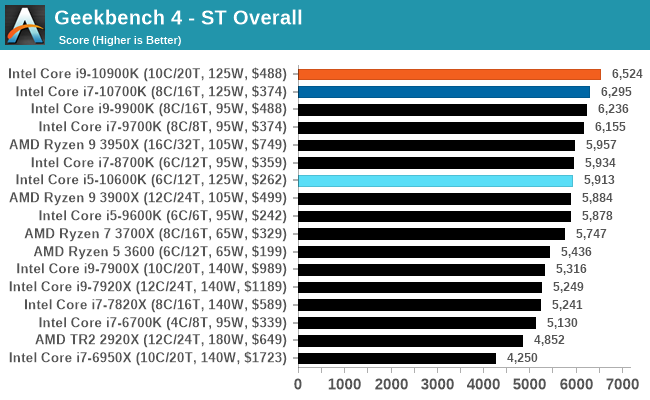
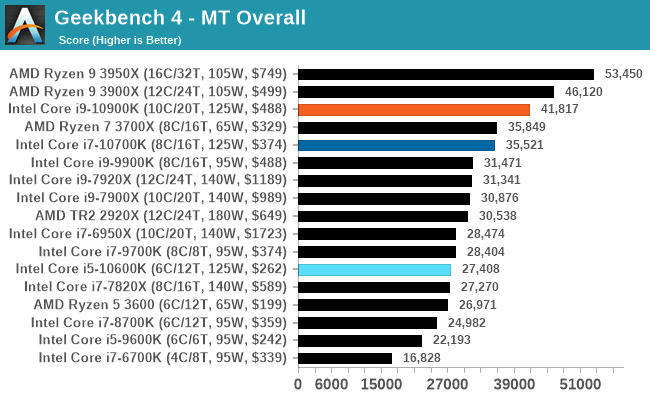
LinX: LINPACK
The main tool for ordering the TOP500 computer list involves running a variant of an accelerated matrix multiply algorithm typically found from the LINPACK suite. Here we use a tool called LinX to do the same thing on our CPUs. We scale our test based on the number of cores present in order to not run out of scaling but still keeping the test time consistent.
This is another of our new tests for 2020. Data will be added as we start regression testing older CPUs.
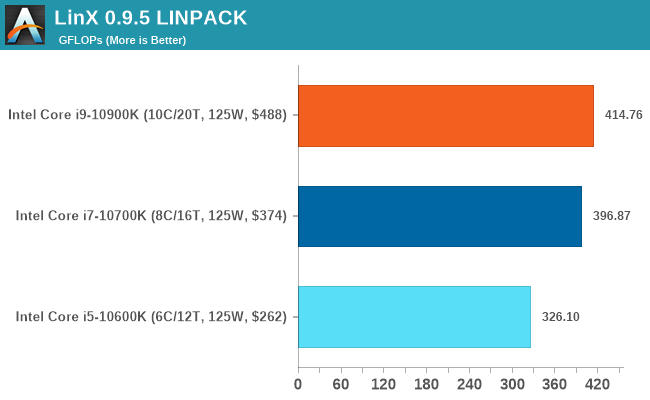
Cinebench R20
The Cinebench line of tests is very well known among technology enthusiasts, with the software implementing a variant of the popular Cinema4D engine to render through the CPU a complex scene. The latest version of Cinebench comes with a number of upgrades, including support for >64 threads, as well as offering a much longer test in order to stop the big server systems completing it in seconds. Not soon after R20 was launched, we ended up with 256 thread servers that completed the test in about two seconds. While we wait for the next version of Cinebench, we run the test on our systems in single thread and multithread modes, running for a minimum of 10 minutes each.
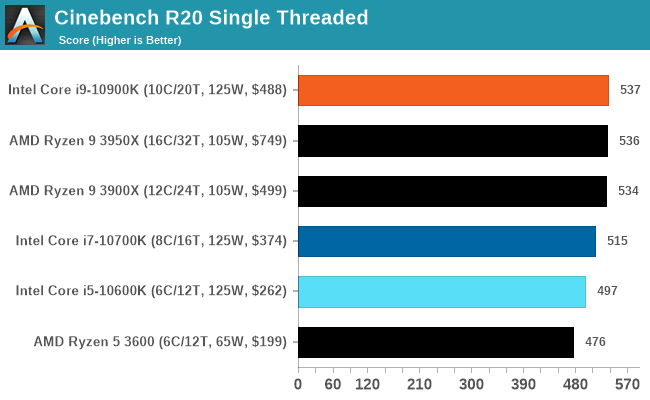
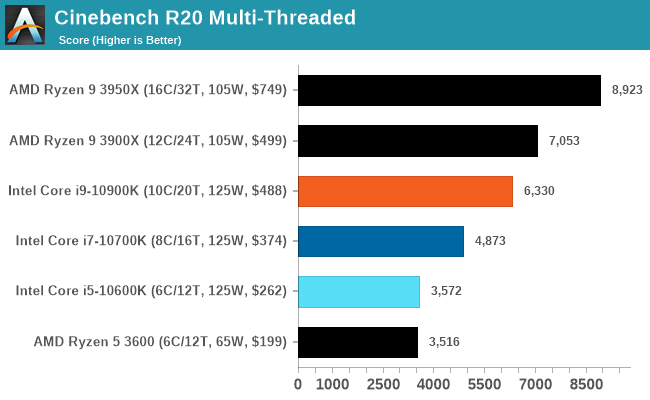










220 Comments
View All Comments
Ryan Smith - Tuesday, May 26, 2020 - link
To be sure, it's GTX 1080. IGP is the name of the setting.F123Nova - Saturday, May 23, 2020 - link
I am trying my best to be nice, but this article has the most dubious set of benchmarks I have seen, and the omission in the charts of Intel competition in certain charts where the competition is better makes me wonder why this article smells of a cash handout. Cant say for sure if this is another "Just buy it" piece, but it sure smells foul. I expected more from Anandtech...Ryan Smith - Tuesday, May 26, 2020 - link
Hi Nova,As has been the case for the past 23 years, we always strive to have accurate reporting, to the best of our abilities.
Given that we're in the process of rolling out some new benchmarks (such as the Crysis software render), we haven't yet had a chance to backfill in results for a number of processors. Unfortunately that's going to take some time. But in the meantime, was there any specific benchmark(s) you were concerned about? That might at least help us better prioritize what to backfill first.
And to be sure, there's no cash handout. That's not how we operate. (Selling out for anything less than an incredibly comfortable retirement isn't very helpful for our future employment prospects)
tvdang7 - Wednesday, May 27, 2020 - link
why couldnt AT use a 3800x instead of a 3700x.pcgpus - Friday, July 10, 2020 - link
Nice review. 10600K might be a new king in games (for fair price).If you want to compare this article with other services You have to go on this link:
https://warmbit.blogspot.com/2020/06/intel-core-10...
There are results from 9 services from 32 games!
After page load please pick up your language from google translate (right side of page).
pcgpus - Friday, July 10, 2020 - link
Nice review. 10900K is the new king in games!If you want to compare this article with other services You have to go on this link:
https://warmbit.blogspot.com/2020/06/intel-core-i9...
There are results from 9 services from 35 games!
After page load please pick up your language from google translate (right side of page).
Meteor2 - Wednesday, July 15, 2020 - link
A new microarchitecture doesn’t require a new process. When PAO immediately went south, I don’t understand why Intel didn’t just implement a new microarchitecture on 14 nm. Surely Ice Lake hasn’t taken four years to develop?Meteor2 - Wednesday, July 15, 2020 - link
*Sunny Cove. God Intel’s code-names are dumbmiss5tability - Saturday, August 8, 2020 - link
i just discovered this INTEL SCAM, now i dont freaking understand how those 10 gen cpu works i wanna buy i3 10300 and what im reading this is not 65W chip? what is real f@#%$@ power draw for those cpusdamian101 - Monday, August 10, 2020 - link
As far as I know Intel never used a single bidirectional ring bus on CPUs with more than 10 cores.On Intel Ivy Bridge CPUs with 12 and more (15) cores, Intel used three unidirectional ring buses. There were also no Sandy Bridge CPUs with more than 10 cores, and Intel used two bidirectional ring buses connected with buffered switches for their high core count Haswell CPUs.